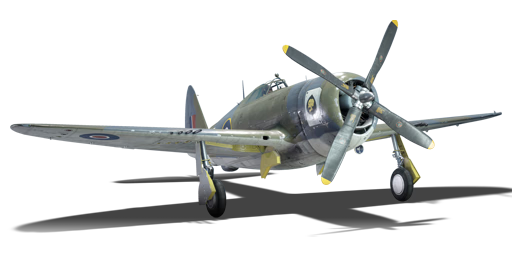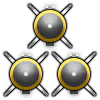

Aviation
▄Thunderbolt Mk.1
III
Rank
AB
3.7
RB
3.7
SB
3.7
Battle rating
Great Britain
Research country
Fighter
Main role
1,600

Purchase

Premium vehicle
Status
General information
Flight performance
Max speed
at 7,924 m
676632704649 km/h
Rate of Climb
11.58.1168.1 m/s
Turn time
2527.223.826.2 s
Max altitude
12,200 m
Takeoff Run
600 m
Landing
flaps
flaps
Take-off
flaps
flaps
Combat
flaps
flaps
Air
brake
brake
General characteristics
Crew
1 person
Engine
Length
10.6 m
Wingspan
12.4 m
Wing Loading
230 kg/m²
Weight:
Base weight
5.275.445.145.41 t
Fuel in main tanks
0.84 t (1h 4m)
Limits:
Max Speed Limit (IAS)
885 km/h
Mach Number Limit
0.9 M
G limit
≈ -6/13 G
Flap Speed Limit (IAS)
L / T / C
320 / 469 / 498 km/h
Gear Speed Limit (IAS)
450 km/h
Offensive armament
8 × 12.7 mm M2 Browning machine gun
Ammunition
3,400 rounds
Fire rate
750 shots/min
One-second Burst Mass
0.54 kg
| Belt | Belt filling | Armor penetration (mm) at a distance: | |||||
|---|---|---|---|---|---|---|---|
| 10 m | 100 m | 500 m | 1000 m | 1500 m | 2000 m | ||
| API-T/AP/AP/I | 30 | 27 | 20 | 13 | 9 | 6 | |
| AP-I/AP-I/API-T/I/I | 28 | 26 | 18 | 11 | 7 | 4 | |
| API-T/I/AP/AP/AP-I/AP-I | 30 | 27 | 20 | 13 | 9 | 6 | |
| API-T | 28 | 26 | 18 | 11 | 7 | 4 | |
| AP-I/I/AP-I/I | 28 | 26 | 18 | 11 | 7 | 4 | |
Suspended armament
Max weight
1,340 kg
Wing loading
left / right
Maximum
670 kg
Max. difference
520 kg
| Name | Weight | Slot | ||||
|---|---|---|---|---|---|---|
| 117.9 kg |  |  |  | |||
| 242.6 kg |  |  |  | |||
| 500.8 kg |  |  | ||||
| 3 × | 51.8 kg |  |  | |||
Economy
Repair cost
AB
695 

RB
4,396 

SB
2,332 

Crew training
10,000 

Experts
165,000 

Aces
590 

Research Aces
710,000 

Reward multiplier
AB / RB / SB
 2 x (70 / 220 / 345) %
2 x (70 / 220 / 345) % 
 2 x 148 %
2 x 148 % 

Premium vehicle
All modifications are unlocked
Flight performance | |
|---|---|
Survivability |
|---|
Weaponry | |
|---|---|
Rating by players
You must play more than 3 battles for the last week and more than 10 battles in a vehicle to rate it.
Like:
14
Flight performance:
Not enough ratings
Survivability:
Not enough ratings
Aerial combat:
Not enough ratings
Ground attack:
Not enough ratings
Balance:
Not enough ratings
Tips & Tricks
This space is currently empty
Do you know any interesting vehicle features?
Loading...
No articles about this vehicle yet
Become the first author and get rewards!
Write a guide, tell about interesting historical facts, make a tutorial or simply an interesting post.
No more content